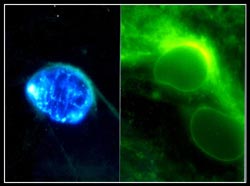The nucleus: Not just a bag of chromosomes

Frog Nuclei
Educators and scientists should discard the idea that a cell’s nucleus is just a bag of chromosomes, according to Johns Hopkins’ cell biologist Kathy Wilson, Ph.D. In a Feb. 17 session at the annual meeting of the American Association for the Advancement of Science (AAAS) in Denver, Wilson and five others will introduce visual evidence of the nucleus’s newly recognized importance.
“The old view is that the nucleus is simply a warehouse for chromosomes,” says Wilson, associate professor of cell biology in the Johns Hopkins School of Medicine’s Institute for Basic Biomedical Sciences. “But new research and imaging techniques show that the nucleus is really the cell’s mothership, a crucial and very active source of information, support and control.”
It’s not too surprising that the nucleus itself has been overshadowed by the easy-to-see reams of genetic material and the fascinatingly tiny machinery that loosens, prepares, reads and copies genes. But in the last 10 or 15 years, evidence has mounted that these interior processes are actively linked to the nucleus, not just randomly taking place inside it, says Wilson, also chair of the public information committee of the American Society for Cell Biology, which helped organize the session.
Wilson and others, for example, are investigating rope-like nuclear proteins called lamins, which form networks throughout the nucleus. A few years ago, scientists discovered that mutations in the gene for “A-type” lamins cause Emery-Dreifuss muscular dystrophy, the third most common of the muscle-wasting disorders.
“That changed everything,” says Wilson. “Until then, it was difficult to get federal funding to study lamins — they were seen as boring. However, once they were linked to a human disease, scientists inside and outside the field appreciated that these proteins are doing unexpected, unexplained things.”
Subsequently, lamin A has been linked to five other diseases, affecting the skeleton, heart, brain and fat, notes Wilson.
Beyond lamins, there’s an emerging revolution in understanding cell division, says Wilson. While the general cycle is well understood — chromosomes are copied and then pulled to opposite ends of the cell, and the cell splits in two — the details are still fuzzy. For one, the chromosomes are inside the nucleus, but the machinery that pulls them to one side or the other is outside the nucleus.
“The nucleus itself has to disappear before the cell can divide, and everyone thought that it just fell apart,” says Wilson. “But recent evidence shows that its breakdown is an orchestrated process similar to the pulling apart of the chromosomes. It seems to involve the same structures and the same tiny motors. It’s almost a practice run for moving the chromosomes.”
Wilson notes that no college textbook yet reflects current understanding of the nucleus.
“Scientists studying the nucleus have just reached the point where we’ve discovered enough to talk about the bigger picture and how our seemingly separate areas overlap,” she adds. “But it’s really important to develop an integrated view of the nucleus.”
That’s one goal of the AAAS session, she notes. The scientists will present recent advances in six areas, including the disassembly of the nucleus during cell division, lamins, links between the nucleus and disease, implications of the “new” nucleus in gene therapy, and the structure and function of “pores” in the nuclear membrane. The best part of the session, Wilson says, is that there will be lots of “cool pictures.”
In addition to Wilson, scheduled presenters are Andrew Belmont of the University of Illinois, Robert Goldman of Northwestern University School of Medicine, Howard Worman of Columbia University College of Physicians and Surgeons, Brian Burke of the University of Florida, and Douglass Forbes of the University of California at San Diego. Tim Richardson of the Toronto Hospital for Sick Children is producing video of various nuclear processes for the session.
Media Contact
All latest news from the category: Life Sciences and Chemistry
Articles and reports from the Life Sciences and chemistry area deal with applied and basic research into modern biology, chemistry and human medicine.
Valuable information can be found on a range of life sciences fields including bacteriology, biochemistry, bionics, bioinformatics, biophysics, biotechnology, genetics, geobotany, human biology, marine biology, microbiology, molecular biology, cellular biology, zoology, bioinorganic chemistry, microchemistry and environmental chemistry.
Newest articles

First-of-its-kind study uses remote sensing to monitor plastic debris in rivers and lakes
Remote sensing creates a cost-effective solution to monitoring plastic pollution. A first-of-its-kind study from researchers at the University of Minnesota Twin Cities shows how remote sensing can help monitor and…

Laser-based artificial neuron mimics nerve cell functions at lightning speed
With a processing speed a billion times faster than nature, chip-based laser neuron could help advance AI tasks such as pattern recognition and sequence prediction. Researchers have developed a laser-based…

Optimising the processing of plastic waste
Just one look in the yellow bin reveals a colourful jumble of different types of plastic. However, the purer and more uniform plastic waste is, the easier it is to…



